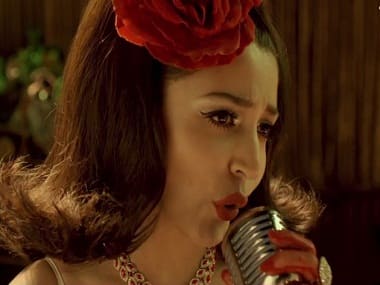By Mitali Parekh If you go to the movies to feast your eyes, then in Bombay Velvet, Rosie’s (Anushka Sharma) costumes serve an all-you-can-eat gourmet buffet for the price of a multiplex ticket. Her on-stage costumes (and those of Raveena Tandon à la Mata Hari) are gloriously detailed and textured — ropes of pearls, cascades of sequins, feathers and tulle. Each costume was testimony to economic stature of the patrons of the jazz club. Bombay Velvet is supposed to be an exclusive gentlemen’s club and its sophistication would not be complete if its primary entertainer wore off-the-rack costumes. Early in her singing career, when she’s performing in a grungy opium den, she wears a tacky, inexpensive red dress with cut-outs and a plastic rose over her eye brow. Her costumes in the far posher gentlemen’s club are similar in their intent – to add drama and spectacle to Rosie’s persona – but once inside Bombay Velvet, opulence shimmers from every detail. Instead of a tacky, plastic flower, now a gigantic silk rose adorns Rose. Each costume looks bespoke and Rosie is no longer a clotheshorse. She’s a star, and she’s dressed like it. [caption id=“attachment_2256202” align=“alignleft” width=“380”]  Anushka Sharma in Bombay Velvet. Image from IBN Live.[/caption] Off stage, Rosie first shows up in frocks as a Goan runaway who works in beauty parlours. As a child who has always received unwanted sexual attention, dressing demurely would be Rosie’s shield in a predatory world. There is much one could read into and take away from the architecture of ‘Pao-wala frocks’ — accordion pleats in skirts – chequered skirt suits, cascading collars, petal sleeves and precise pin tucks. And that’s where authenticity ends in Bombay Velvet. No detail is as discordant as the cheap, floppy, synthetic hat in the crowd scene, set in Goa, when Rosie’s tormentor and teacher (Remo Fernandes) first approaches her mother and asks if he can tutor Rosie of the angelic voice. This is Goa of the 1950s, governed by the Portuguese. Women would get the hats they wore to church from skilled milliners. Hats were once-in-a-while treats and hardly cheap, thus afforded by women of some stature and connections. The rest wore scarves. That hat is a lazy Bollywood ploy to indicate Westernness. We’ve seen it so many times, in the crowd and on heroines who have returned from Abroadland (remember Manisha Koirala in Saudagar?) Bombay Velvet is set in the ’60s, but the wardrobe – particularly the men’s – is from the ’40s. Shammi Kapoor, Rajesh Khanna, Dev Anand were already showing Bombay what the ’60s would bring — two-button suits, slimmer pants, sleek hair. Costume designer Niharika Bhasin’s gives us a taste of the decade to come in glimpses of polka and pin dots, but it is not enough. Those strong shoulders on double-breasted suits, the pleated trousers, Johnny Balraj’s (Ranbir Kapoor) curly asymmetrical crop, the scalloped pocket flaps and the eye-wear – all this is from two decades before the story’s proclaimed setting. One could argue that people don’t spontaneously change into shifts and psychedelic prints as the clock strikes 12 on 1.1.1960, but we cannot be two decades behind. The only group who would warrant the ’40s’ echo are the policemen. Government uniforms don’t change with trends and they are right in wearing broad, short ties and high trousers. Speaking of policemen, the flair with which Inspector Vishwas Kulkarni (Kay Kay Menon) wears his trilby makes one curious — is he echoing Guru Dutt or Shaheed Bhagat Singh? As a Hindu man of that era, it’s a little unlikely that he wears a gold band. Let’s presume that Kaizad Khambatta (Karan Johar) is a man in his 40s and therefore holds on a style that he found to work for him, as many people do. But what about Balraj? As he turns into Johnny, the first thing the street-fighter earns is a military jacket of gentrification. It could be that he starts modelling himself on Kaizad, but there is no indication of such loyalty in Johnny’s personality. He, of all people, would be the first one to dress like one of the Beatles, surely. Johar’s Khambatta is a cinematic marker because he plays a character, not simply a token gay man. And Bhasin underscores this point by avoiding stereotypes such as pastels and pinks. Small accessories give away the wealth he is born into — cravats, lapel pins and glasses that could have belonged to his grandmother. Among these, the signet ring speaks most loudly. In Victorian times, a ring on the little finger indicated a disinterest in marriage, which could apply to Khambatta. In the 1950s and 1960s, it indicated homosexuality. Khambatta ticks that box too. Conmen in America wore a gold ring on the pinky finger to provide for their funerals. Khambatta is quickly revealed to be a conman and at one point in the film, he reveals he was born into old money that was drained away, and which he’s determined to rebuild. Touché. There is evidently a lot of thought, care and money that has been lavished upon the costumes in Bombay Velvet. They’re used to paint a sumptuous portrait of a vintage Bombay, which may be striking and stylish; but for most part, it isn’t authentic.
If you go to the movies to feast your eyes, then in Bombay Velvet, Rosie’s (Anushka Sharma) costumes serve an all-you-can-eat gourmet buffet for the price of a multiplex ticket
Advertisement
End of Article
Written by FP Archives
see more


)
)
)
)
)
)
)
)
)



